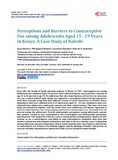| dc.contributor.author | Kinaro, Joyce | |
| dc.contributor.author | Kimani, Murungaru | |
| dc.contributor.author | Ikamari, Lawrence | |
| dc.contributor.author | Ayiemba, Elias H. O. | |
| dc.date.accessioned | 2015-06-09T06:23:59Z | |
| dc.date.available | 2015-06-09T06:23:59Z | |
| dc.date.issued | 2015 | |
| dc.identifier.citation | Kinaro, Joyce;Kimani, Murungaru;Ikamari, Lawrence ;Ayiemba, Elias H. O;Perceptions and barriers to contraceptive use among adolescents aged 15 - 19 years in Kenya: a case study of nairobi, Health. 2015;07(01)85-97 | en_US |
| dc.identifier.uri | https://doaj.org/article/9c98846ce2c548a482e3604b09fe84b6 | |
| dc.identifier.uri | http://hdl.handle.net/11295/84421 | |
| dc.description.abstract | Even after the launch of family planning program in Kenya, in 1967, contraceptive use among adolescents has remained below 10 percent while child bearing has increased from 2 percent at age 15 to 36 percent at age 19. To understand the roles of perceptions and barriers on contraceptive use, a mixed method study design was applied to a conceptual framework that operationalized these concepts using data from different sources of social interactions in Nairobi, Kenya. Quantitative data were collected from 1119 adolescents aged 15 - 19 years. Qualitative data were collected from adolescents, adolescents’ parents and their school teachers. The later were analyzed and interpreted together with the results from cross-tabulations and logistic regression in order to understand the roles of perceptions and barriers. Contraceptive use was found to be 8.6 percent among the adolescents. Overall, unfavourable perceptions among adolescents, parents and teachers seemed to have contributed to low contraceptive use. Unfavourable perceptions played greater role compared to barriers such as sexual partner communication, opinion on adolescents to use a contraceptives and ability to seek contraceptives. Qualitative data show that teachers and parents lack adequate information and skills to discuss sexuality issues. Linking data among adolescents, parents and teachers help to understand the roles of perceptions and barriers to contraceptive use in Kenya. The findings suggest capacity building of teachers and parents on accurate sexuality information for adolescents while services should be youth-friendly. | en_US |
| dc.language.iso | en | en_US |
| dc.publisher | University of Nairobi | en_US |
| dc.title | Perceptions and barriers to contraceptive use among adolescents aged 15 - 19 years in Kenya: a case study of Nairobi | en_US |
| dc.type | Article | en_US |
| dc.type.material | en_US | en_US |

